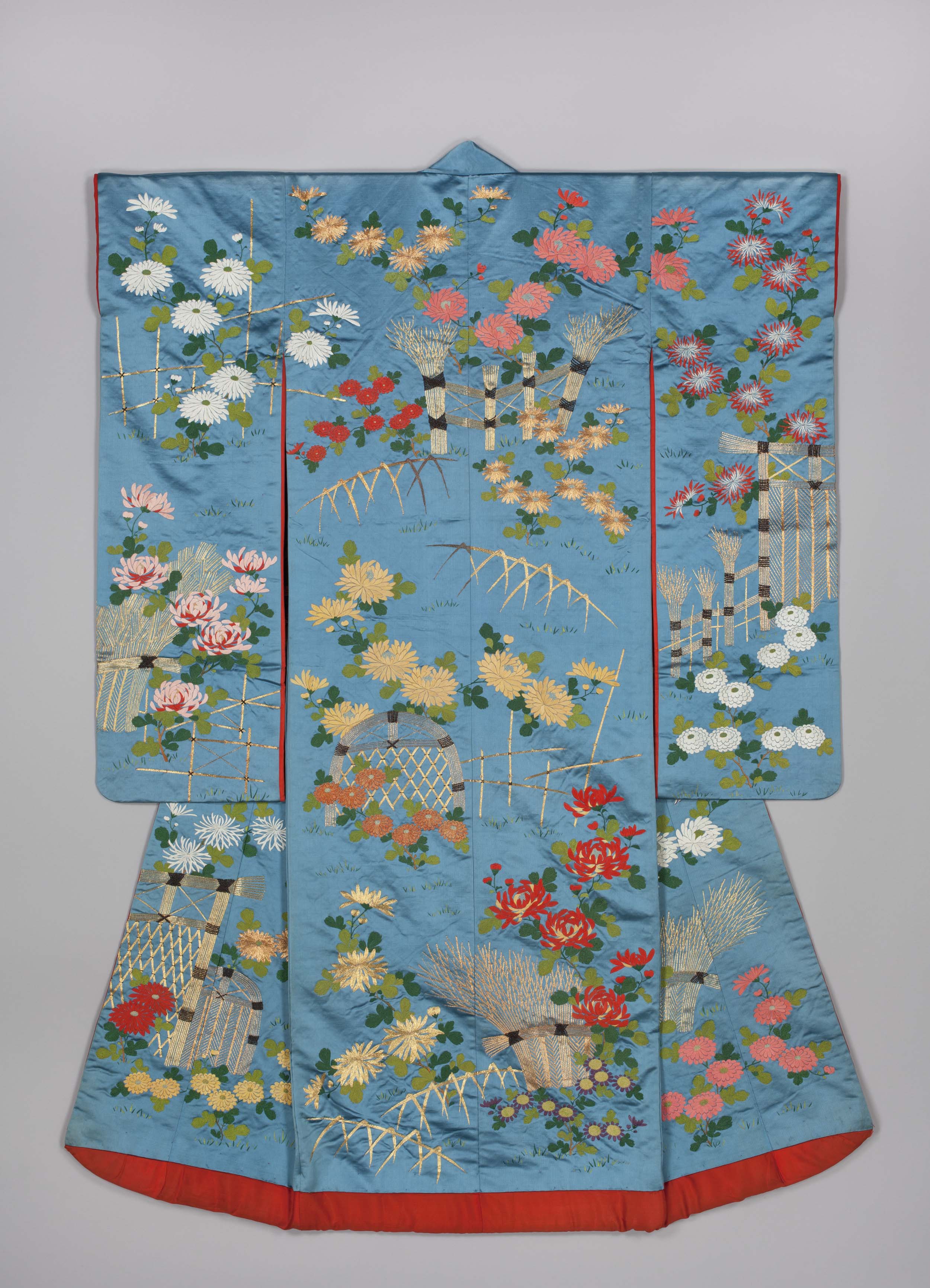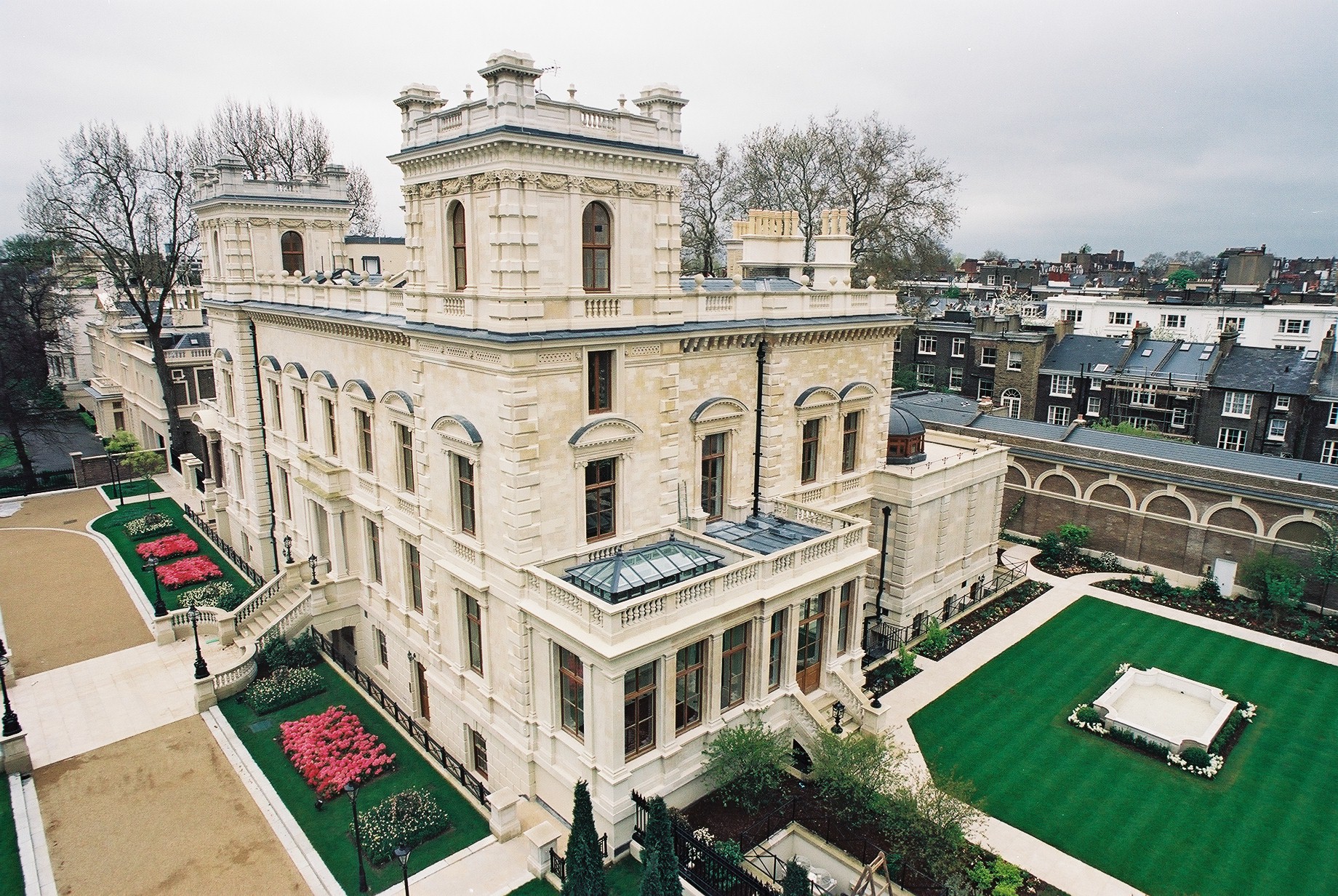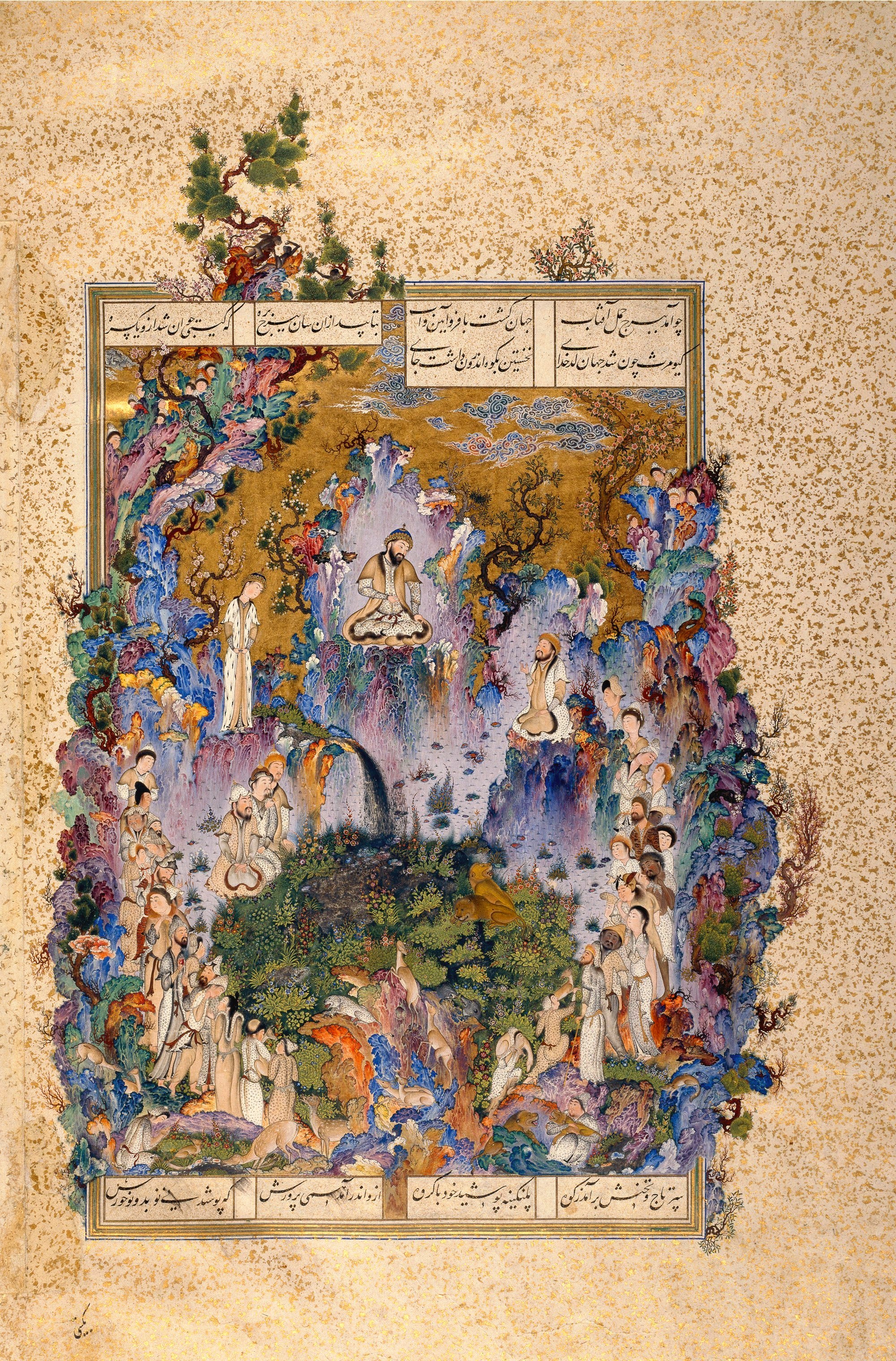|
Khalili Collection
The Khalili Collections are eight distinct art collections assembled by Nasser D. Khalili over five decades. Together, the collections include some 35,000 works of art, and each is considered among the most important in its field. Among these are the largest private collection of Islamic art, with 28,000 items including 2,000 ceramics and 600 items of jewellery. A separate collection includes around 5,000 objects relating to the Hajj, spanning from the 7th century AD to the present day. From Japan, there are 1,600 items of Meiji era decorative art and another collection of more than 450 kimono, covering a 300-year period. The most comprehensive private collection of enamels, with over 1,300 items, includes items from China, Japan, Europe and Islamic lands. The eight collections also include 100 flatweave textiles from southern Sweden, 100 examples of Spanish damascened metalwork (i.e. with metal inlaid into other metal), and 48 Aramaic documents from 4th century-BC Bactr ... [...More Info...] [...Related Items...] OR: [Wikipedia] [Google] [Baidu] |
Khalili Collection Of Japanese Art
The Khalili Collection of Japanese Art is a private collection of decorative art from Meiji-era (1868–1912) Japan, assembled by the British-Iranian scholar, collector and philanthropist Nasser D. Khalili. Its 1,400 art works include metalwork, enamels, ceramics, lacquered objects, and textile art, making it comparable only to the collection of the Japanese imperial family in terms of size and quality. The Meiji era was a time when Japan absorbed some Western cultural influences and used international events to promote its art, which became very influential in Europe. Rather than covering the whole range of Meiji-era decorative art, Khalili has focused on objects of the highest technical and artistic quality. Some of the works were made by artists of the imperial court for the Great Exhibitions of the late 19th century. The collection is one of eight assembled, published, and exhibited by Khalili. Although the collection is not on permanent public display, its objects are ... [...More Info...] [...Related Items...] OR: [Wikipedia] [Google] [Baidu] |
Khalili Collection Of Kimono
The Khalili Collection of Kimono is a private collection of Japanese kimono assembled by the British-Iranian scholar, collector and philanthropist Nasser D. Khalili, containing more than 450 items. It is one of eight collections assembled, published and exhibited by Khalili, each of which is considered to be among the most important collections within their respective fields. The Khalili Collection of Kimono includes formal, semi-formal, and informal kimono made for men, women, and children, illustrating the evolution of the kimono through cut, construction, materials, and decorative techniques from the 17th through the 20th centuries, with kimono representing the Edo period, the Meiji period, the Taishō period, and the Shōwa period. The kimono within the collection are not on permanent display, but are periodically lent or donated in part to cultural institutions; including the Kremlin Museums in Moscow and the Victoria and Albert Museum in London. Khalili, who also owns a ... [...More Info...] [...Related Items...] OR: [Wikipedia] [Google] [Baidu] |
Nasser Khalili
Sir Nasser David Khalili ( fa, ناصر داوود خلیلی, born 18 December 1945) is a British-Iranian scholar, collector, and philanthropist based in London. Born in Iran and educated at Queens College, City University of New York and the School of Oriental and African Studies in London, he is now a British citizen."Biographical Notes" in Earle, Joe (ed.) ''Shibata Zeshin: Masterpieces of Japanese Lacquer from the Khalili Collection''. London: Kibo Foundation, 1997. p. 80. Khalili has assembled eight art collections—the Khalili Collections—each considered among the most important in its field. These collections total 35,000 artworks and include the largest private collection of Islamic art and a collection of Japanese art rivalling that of the Japanese imperial family. He has spent tens of millions of pounds on conserving, researching, and documenting the collections, publishing more than seventy volumes of catalogues and research so far. Exhibitions drawn from the coll ... [...More Info...] [...Related Items...] OR: [Wikipedia] [Google] [Baidu] |
Arab World Institute
The ''Institut du Monde Arabe'', French for Arab World Institute, abbreviated ''IMA'', is an organization founded in Paris in 1980 by France with 18 Arab countries to research and disseminate information about the Arab world and its cultural and spiritual values. The Institute was established as a result of a perceived lack of representation for the Arab world in France, and seeks to provide a secular location for the promotion of Arab civilization, art, knowledge, and aesthetics. Housed within the institution are a museum, library, auditorium, restaurant, offices and meeting rooms. History The AWI is located in a building known as the ''Institut du Monde Arabe'', the same name as the institute, on Rue des Fossés Saint Bernard in the 5th arrondissement of Paris, France. Originally, the project was conceived in 1973 by President Valéry Giscard d'Estaing. The museum was constructed between 1981 and 1987 under the presidency of French President Francois Mitterrand as part of his ... [...More Info...] [...Related Items...] OR: [Wikipedia] [Google] [Baidu] |
Sotheby's
Sotheby's () is a British-founded American multinational corporation with headquarters in New York City. It is one of the world's largest brokers of fine and decorative art, jewellery, and collectibles. It has 80 locations in 40 countries, and maintains a significant presence in the UK. Sotheby's was established on 11 March 1744 in London by Samuel Baker, a bookseller. In 1767 the firm became Baker & Leigh, after George Leigh became a partner, and was renamed to Leigh and Sotheby in 1778 after Baker's death when Leigh's nephew, John Sotheby, inherited Leigh's share. Other former names include: Leigh, Sotheby and Wilkinson; Sotheby, Wilkinson and Hodge (1864–1924); Sotheby and Company (1924–83); Mssrs Sotheby; Sotheby & Wilkinson; Sotheby Mak van Waay; and Sotheby's & Co. The American holding company was initially incorporated in August 1983 in Michigan as Sotheby's Holdings, Inc. In June 2006, it was reincorporated in the State of Delaware and was renamed Sotheby's. In ... [...More Info...] [...Related Items...] OR: [Wikipedia] [Google] [Baidu] |
The Wall Street Journal
''The Wall Street Journal'' is an American business-focused, international daily newspaper based in New York City, with international editions also available in Chinese and Japanese. The ''Journal'', along with its Asian editions, is published six days a week by Dow Jones & Company, a division of News Corp. The newspaper is published in the broadsheet format and online. The ''Journal'' has been printed continuously since its inception on July 8, 1889, by Charles Dow, Edward Jones, and Charles Bergstresser. The ''Journal'' is regarded as a newspaper of record, particularly in terms of business and financial news. The newspaper has won 38 Pulitzer Prizes, the most recent in 2019. ''The Wall Street Journal'' is one of the largest newspapers in the United States by circulation, with a circulation of about 2.834million copies (including nearly 1,829,000 digital sales) compared with ''USA Today''s 1.7million. The ''Journal'' publishes the luxury news and lifestyle magazine ' ... [...More Info...] [...Related Items...] OR: [Wikipedia] [Google] [Baidu] |
Shah Jahan
Shihab-ud-Din Muhammad Khurram (5 January 1592 – 22 January 1666), better known by his regnal name Shah Jahan I (; ), was the fifth emperor of the Mughal Empire, reigning from January 1628 until July 1658. Under his emperorship, the Mughals reached the peak of their architectural achievements and cultural glory. The third son of Jahangir (), Shah Jahan participated in the military campaigns against the Rajputs of Mewar and the Lodis of Deccan. After Jahangir's death in October 1627, Shah Jahan defeated his youngest brother Shahryar Mirza and crowned himself emperor in the Agra Fort. In addition to Shahryar, Shah Jahan executed most of his rival claimants to the throne. He commissioned many monuments, including the Red Fort, Shah Jahan Mosque and the Taj Mahal, where his favorite wife Mumtaz Mahal is entombed. In foreign affairs, Shah Jahan presided over the aggressive campaigns against the Deccan Sultanates, the conflicts with the Portuguese, and the wars with S ... [...More Info...] [...Related Items...] OR: [Wikipedia] [Google] [Baidu] |
Astrolabe
An astrolabe ( grc, ἀστρολάβος ; ar, ٱلأَسْطُرلاب ; persian, ستارهیاب ) is an ancient astronomical instrument that was a handheld model of the universe. Its various functions also make it an elaborate inclinometer and an analog calculation device capable of working out several kinds of problems in astronomy. In its simplest form it is a metal disc with a pattern of wires, cutouts, and perforations that allows a user to calculate astronomical positions precisely. Historically used by astronomers, it is able to measure the altitude above the horizon of a celestial body, day or night; it can be used to identify stars or planets, to determine local latitude given local time (and vice versa), to survey, or to triangulate. It was used in classical antiquity, the Islamic Golden Age, the European Middle Ages and the Age of Discovery for all these purposes. The astrolabe's importance comes not only from the early developments into the study of astron ... [...More Info...] [...Related Items...] OR: [Wikipedia] [Google] [Baidu] |
Genghis Khan
Genghis Khan (born Temüjin; ; xng, Temüjin, script=Latn; ., name=Temujin – August 25, 1227) was the founder and first Great Khan (Emperor) of the Mongol Empire, which became the List of largest empires, largest contiguous empire in history after his death. He came to power by uniting many of the nomadic tribes of the Mongol steppe and being proclaimed the universal List of Mongol rulers, ruler of the Mongols, or ''Genghis Khan''. With the tribes of Northeast Asia largely under his control, he set in motion the Mongol invasions and conquests, Mongol invasions, which ultimately witnessed the conquest of much of Eurasia, and incursions by Mongol raiding parties as far west as Legnica in Mongol Empire#Push into central Europe, western Poland and as far south as Gaza City, Gaza. He launched campaigns against the Mongol conquest of the Qara Khitai, Qara Khitai, Mongol conquest of the Khwarazmian Empire, Khwarezmia, the Mongol conquest of Western Xia, Western Xia and Mongol conquest ... [...More Info...] [...Related Items...] OR: [Wikipedia] [Google] [Baidu] |
Rashid-al-Din Hamadani
Rashīd al-Dīn Ṭabīb ( fa, رشیدالدین طبیب; 1247–1318; also known as Rashīd al-Dīn Faḍlullāh Hamadānī, fa, links=no, رشیدالدین فضلالله همدانی) was a statesman, historian and physician in Ilkhanate Iran."Rashid ad-Din" ''Encyclopædia Britannica''. 2007. Encyclopædia Britannica Online. Accessed 11 April 2007. He was born in 1247 into a ish family from Hamadan. Having converted to by the age of 30, Rashid al-Din became the powerful |
Jami' Al-tawarikh
The ''Jāmiʿ al-tawārīkh'' ( Persian/Arabic: , ) is a work of literature and history, produced in the Mongol Ilkhanate. Written by Rashid al-Din Hamadani (1247–1318 AD) at the start of the 14th century, the breadth of coverage of the work has caused it to be called "the first world history". It was in three volumes and published in Arabic and Persian versions. The surviving portions total approximately 400 pages of the original work. The work describes cultures and major events in world history from China to Europe; in addition, it covers Mongol history, as a way of establishing their cultural legacy. The lavish illustrations and calligraphy required the efforts of hundreds of scribes and artists, with the intent that two new copies (one in Persian, and one in Arabic) would be created each year and distributed to schools and cities around the Ilkhanate, in the Middle East, Central Asia, Anatolia, and the Indian subcontinent. Approximately 20 illustrated copies were made o ... [...More Info...] [...Related Items...] OR: [Wikipedia] [Google] [Baidu] |
Shahnameh Of Shah Tahmasp
The ''Shahnameh'' of Shah Tahmasp ( fa, شاهنامه شاهطهماسب) or Houghton ''Shahnameh'' is one of the most famous illustrated manuscripts of the ''Shahnameh'', the national epic of Greater Iran, and a high point in the art of the Persian miniature. It is probably the most fully illustrated manuscript of the text ever produced. When created, the manuscript contained 759 pages, 258 of which were miniatures. These miniatures were hand-painted by the artists of the royal workshop in Tabriz under rulers Shah Ismail I and Shah Tahmasp I. Upon its completion, the ''Shahnameh'' was gifted to Ottoman Sultan Selim II in 1568. The page size is about 48 x 32 cm, and the text written in Nastaʿlīq script of the highest quality. The manuscript was broken up in the 1970s and pages are now in a number of different collections around the world. History It was created in Tabriz at the order of Shah Ismail I who had recently taken control of the city. Shah Ismail I was a ... [...More Info...] [...Related Items...] OR: [Wikipedia] [Google] [Baidu] |










